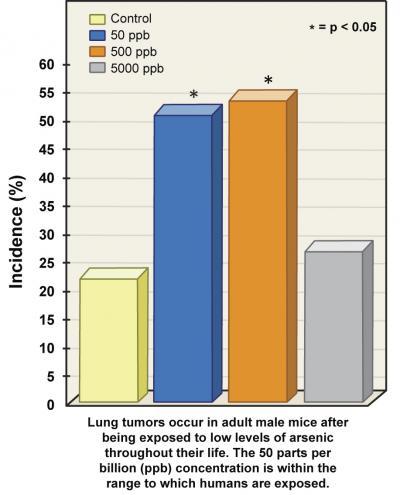Mice exposed to arsenic in drinking water developed lung cancer in a new study by researchers at the National Institutes of Health have found.
In the study, researchers gave mice orders of magnitude acceptable limits of arsenic in water - 5X the EPA maximun, 50X and 500X. The reason they used so much is because mice need to be exposed to greater concentrations of arsenic in drinking water than humans to achieve the same biological dose and similar health effects. Arsenic in public drinking water cannot exceed 10 parts per billion (ppb) by U.S. Environmental Protection Agency regulations. Private wells, from which millions of people get their drinking water, don't have a specified standard because arsenic is found in nature.
The researchers created a framework in the mice similar to how humans can be exposed to arsenic throughout their entire lifetime. In the study, the mice were given the high levels of arsenic three weeks before breeding (equivalent to 2 human years) and throughout pregnancy and lactation. Arsenic was then given to the offspring after weaning, and all through adulthood at concentrations relevant to human exposure. The researchers looked at the tumors in the adult offspring.

Lung tumors occur in adult male mice after being exposed to low levels of arsenic throughout their life. The 50 parts per billion (ppb) concentration is 5X the EPA maximum but possible within the range to which humans are exposed. Credit: NIEHS
"This is the first study to show tumor development in animals exposed to very low levels of arsenic, levels similar to which humans might be exposed," said Michael Waalkes, Ph.D., lead author on the paper and director of the National Toxicology Program (NTP) Laboratory. "The results are unexpected and certainly give cause for concern."
The problem, of course, is that mice are not just small humans. There is a reason so many drug trials succeed at the animal stage and fail the first clinical trial. And artificially feeding an animal high levels of arsenic that could be found in nature is not the same thing as finding it in nature. Arsenic is found in many foods, including grains, fruits, and vegetables, where it is present due to absorption from the soil and water. This study focused on inorganic arsenic, which would be very uncommon in natural well water.
In the study, more than half of the male offspring mice developed significant increases in benign and malignant lung tumors at the two lower doses (50 ppb and 500 ppb). Female offspring also developed benign tumors at the lower concentrations. Interestingly, the researchers did not find significant increases in lung tumors in either sex at the highest dose (5,000 ppb).
"Although this is only one study, it adds to a growing body of evidence showing adverse health effects from very low exposures to arsenic, raising the possibility that no level of arsenic appears to be safe," said Linda Birnbaum, Ph.D, director of the National Institute of Environmental Health Sciences (NIEHS) and NTP.





Comments